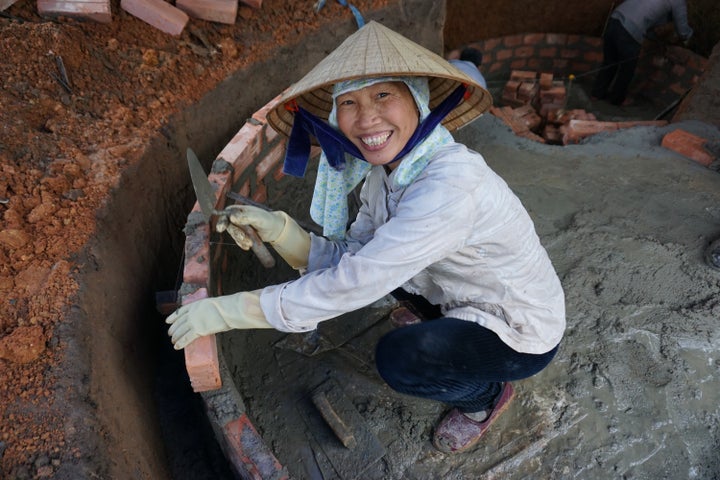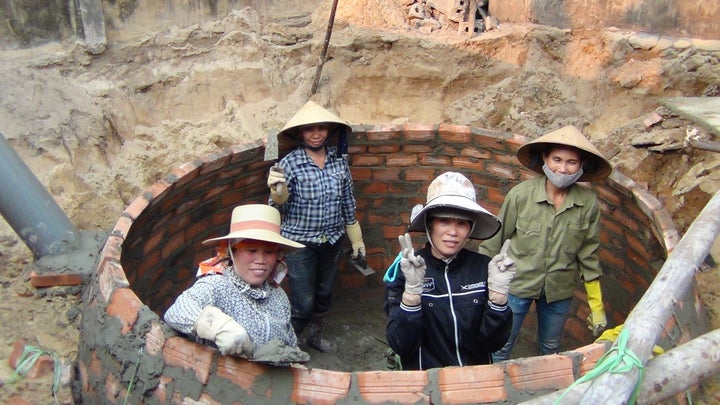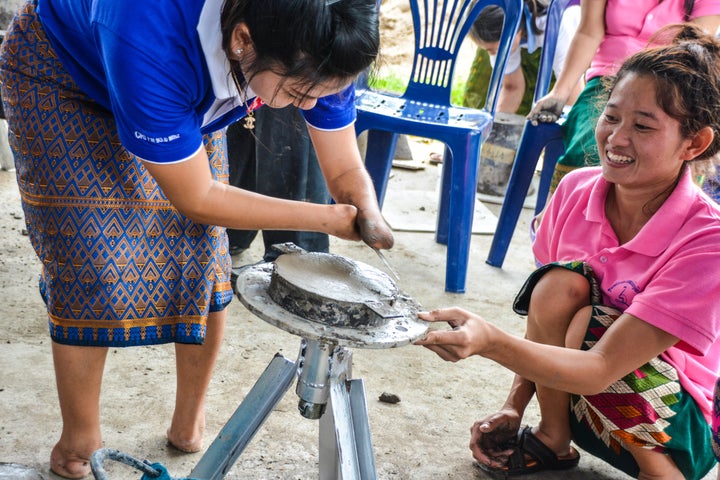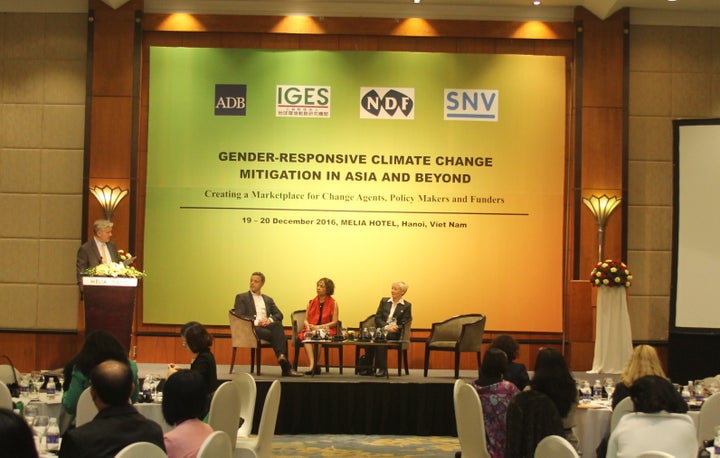Although more and more people recognize that women are impacted by the effects of climate change in developing nations, very little work has been done to date on the special roles women can play in mitigating the causes of climate change. This is beginning to change. At the forefront of this transformation has been a pilot program in Vietnam, Laos and Cambodia (financed by the Nordic Development Fund, managed by the Asia Development Bank, and implemented by both the Institute for Global Environmental Strategies and SNV - the Netherlands Development Organisation) I interviewed the project manager of this program, Linda Adams of the Asia Development Bank, to find out more:
Question 1. How would you explain women’s role in Climate Change mitigation?
Answer: Women and girls in developing countries are usually the ones expected to look after the energy needs in a household, as well as manage waste and collect water. Their (often) lower societal status means that everyday problems such as walking long distances to collect wood fuel or breathing in hazardous fumes from traditional stoves generally go unnoticed. As women have less say in how community and household resources are allocated, it is not surprising they tend to have limited access to, and knowledge of, fuel-efficient stoves or alternative technologies to dispose of waste (and turning it into fuel sources). These limitations then determine what type of fuel is used to cook meals or heat homes.
Helping women gain access to and invest in technologies which address priority concerns, improves incomes, and reduces greenhouse gas emissions can be powerful. For example, in a project undertaken in the Mekong region, a revolving fund was set up so that Vietnamese women farmers, traditionally responsible for taking care of household livestock (and their waste), could afford to purchase biogas digesters, which safely treat manure and capture ‘clean’ biogas energy to power the family stove and, for some, provide new income streams such as chicken hatcheries. Without proper management of this waste, it can be discharged into the environment as methane, a potent greenhouse gas that contributes to climate change. The biogas digester output, or ‘bio-slurry’, is now being sold as an organic fertilizer or used directly in backyard gardens to help grow surplus vegetables for sale, thus improving women’s livelihoods.

In Vietnam, the project trained female masons to construct biogas digesters. They are all now accredited as masons for government of Vietnam National Biogas Program.

Vietnamese trained female masons construct biogas digesters.
Question 2. Why do you believe women’s roles in climate change mitigation have been ignored for so long?
Answer: Governments tend to think of activities to address climate change as ‘men’s work’, while post-disaster community cleanup activities are seen as ‘women’s work’. At the same time, most climate change mitigation efforts have focused on large-scale technology solutions like wind turbine or hydropower energy systems, where climate finance has been easier to access. However, our projects have demonstrated that women can be part of the solution through activities such as: skills training to manufacture and sell energy efficient household stoves; financial support to invest in bio-digesters which reduce greenhouse gas emissions; and increased knowledge to contribute to the preparation of national climate change strategies.

In Laos, a fuel-efficient cook stove production center.
Question 3. How have ADB and other partners worked to change the status quo in your pilot projects in Vietnam, Laos and Cambodia?
Answer: Through our projects in Vietnam, Laos, and Cambodia, ADB has helped women set up low-carbon technology businesses and complimented this by working with government stakeholders to improve their understanding of how they can better support climate mitigation with policies that also benefit women.
In Vietnam, for example, women masons were trained to build household biogas digesters themselves. The project has now trained women in one of the coastal cities in Vietnam, designated high climate risk, on the use and benefits of biogas digesters, as well as on business development and sales skills. These small, but strategic, activities have enabled them to actively respond to climate change. The project has also improved the National Biogas Program to expand potential benefits to women producers and users of biogas technologies. This has been achieved by updating training materials and methods so that they are less intimidating to potential women trainees and enhancing the capacity of male trainers, who were previously inexperienced in training women masons.
We did something a bit different in Laos by working with disabled women, many who had lost limbs from unexploded ordnances—remnants from the secret war, during the Vietnam War, fought in Laos. The project established a fuel-efficient cook stove production center, adapting production equipment for the less abled, and provided training in stove manufacturing, business development, and marketing. Not only has the production center provided employment opportunities in the active stoves market, but it has also helped the country make major strides towards its targets for greenhouse gas reduction under the National Improved Cook Stove Program.

The Lao Women's Disabled Development Center, where the project has constructed a production center and trained disabled women to construct improved cook stoves.
Finally, in Cambodia, ADB partnered with the private sector in a pilot program to train women as sales agents for fuel-efficient cook stoves. Not only did this improve stove access in rural Cambodia, but it also improved private sector operations. With women now representing over 70% of newly trained sales agents, Cambodians have learned that supporting women’s access to technology makes good business sense. As a result of the pilot demonstrations, our Cambodian government partners have developed two project proposals seeking climate finance, replicating the pilot project model.
Question 4. You held a workshop in December 2016 to gather together key actors and policymakers in gender and climate change mitigation. What was the purpose of the workshop, and what in fact did it accomplish?
Answer: The purpose of the workshop, entitled “Gender-Responsive Climate Change Mitigation in Asia and Beyond: Creating a Marketplace for Change Agents, Policy Makers and Funders”, was 3- fold: to create a ‘marketplace’ where stakeholders dedicated to gender and climate change mitigation could showcase their initiatives and identify opportunities to collaborate; to consider ways to expand ongoing work and inspire new gender-responsive mitigation actions using this collective knowledge; and to secure further interest and financial support to advance the work of the showcased initiatives.
For local government partners in Cambodia, Lao PDR, and Vietnam, having a chance to meet with international gender and climate change experts and global climate finance partners had an empowering effect. One of Cambodia’s government ministry representatives expressed how their growing understanding of the links between gender and climate change has allowed them to better reevaluate their own priorities and provided them with the necessary tools to support implementation work.
From a strategic point of view, the workshop enabled partners to take their commitments to a higher level. A major international conservation organization proposed to facilitate Lao PDR’s preparation of a national plan for climate change and gender action, with the assistance of ADB project resources. Such endeavors serve as an anchor to global agreements on gender equality and environmental sustainability within national climate change strategies, thereby inserting a gender lens in policy and planning for the first time.
Experts from climate finance institutions also gained further insights into the challenges faced by government partners in translating global policy to country actions. They recognized that there is a need to provide basic information about the complex workings of United Nation’s climate change fund so that developing countries can access it more easily. Similarly, the Green Climate Fund, with over five billion dollars in available funding, realized that they are not particularly well represented in Southeast Asia. One of the capacity development activities under the ADB projects was to train government agencies on how to prepare project proposals for climate financing. Lao and Cambodian partners have taken full advantage of their training and will each be submitting proposals to access finance from the Global Climate Fund.

Question 5. Looking ahead, what are the next steps in scaling up the capabilities of women to fully use their power in combatting Climate Change?
Answer: We need to see women and women’s groups being fully involved in key policy making regarding climate change. The Lao Women’s Union is now a permanent member of the government’s National Climate Change Technical Working Group which is a huge step forward to ensuring women’s issues are considered as a part of the country’s climate change policy making. The next critical step will be transitioning from grant-financed projects under ADB, to Southeast Asian governments investing in their own gender-responsive climate change programs. This will help ensure that the vital role women play in climate change mitigation will continue to be recognized and institutionalized.
Final Question: What lessons can policymakers and change agents take away from these programs?
Answer: Three things:
1. Find partners. Chances are, others are striving for the same changes as you. Look beyond your silo. Sometime it’s easier and more effective to communicate between organizations than within silos. If you speak to people with authority from the outside, they can sometimes use their channels to get back into your silo and get your information across. Of course, whenever working with different partners, remember they will be driven by different incentives. You have to know what motivates them
2. Develop expertise. You need to have the knowledge to earn you a seat at the table. In our project, among other things, women received training within ministries on how to write proposals to access climate investment funds. When they started receiving grant money, their expertise was recognized, and they became respected – and heard.
3. Share your knowledge. Up, down, and out. Never take it for granted that people will make the effort to seek out and learn new knowledge on their own. We worked on making sure new information was shared up and down, from minister to farmer. Farmers were the ones being asked to accept new technologies, such as more efficient cook stoves. We could not just assume they would take up this innovation. They had to learn about the benefits. Within the ministries, we also trained officials so that they could know that women can take leading roles. This required a real change from them. It did not just happen.
Then, be sure to share outwards. In our project, three countries collaborated. Several ministries were involved, plus many other organizations. We all collaborated, learning from each other, creating new norms. This not only cements the new learning in place, it also sets us up to expand the work within the Mekong, and outwards to other countries who now have three good examples to learn from.
Linda Adams is a Senior Social Development Specialist for Asian Development Bank, Southeast Asia operations, responsible for gender, social and poverty analysis and programming. Mainstreaming gender in relation to environment and sustainable development issues has been a primary focus of her work portfolio as the ADB Gender and Climate operations focal. Prior to joining ADB, developed programs for community-based natural resource conservation and management, national poverty targeting and safety-net strategies, and pro-poor tourism; led institutional gender assessments and preparation of corporate and program gender action plans for UN agencies, INGOs, and bilateral development agencies. She holds an MA in Rural Development.
Project resource links:
Policy Brief: Making Climate Finance Work for Women
Conference Website and further resources: Gender Responsive Climate Change Mitigation in Asia and Beyond
Tim Ward is the author of The Master Communicator’s Handbook
